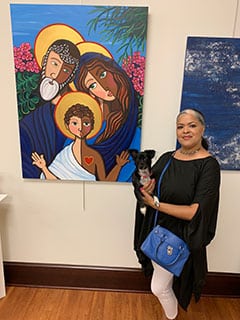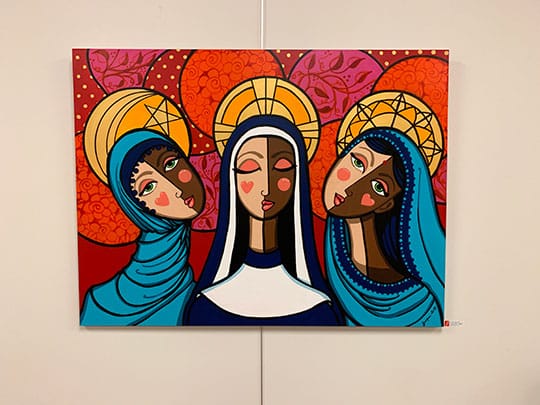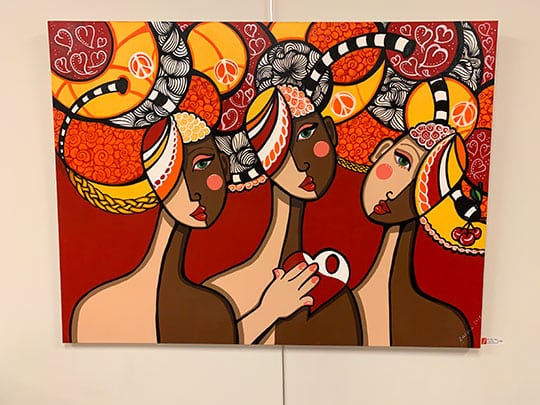
A neo-pop artist based out of Lawrenceville, Jacqui started painting only about a year ago, although her background in fashion design is evident in her work, which is distinguished by the use of bold lines and pristine patterns on a large canvas using bright, neon acrylic paints and pens.
“Pop art is about using familiar images of popular culture and society, like Andy Warhol, who did images of soup cans. But neo-pop, is an adaption of that, incorporating other aspects of culture and life,” said Jacqui. Even before developing an aesthetic, Jacqui used her work to visualize pressing current events.
Dabbling with abstracts, Jacqui painted “Car Fire”, an interpretation of the wildfires that ravaged California in late 2018. She’s since abandoned abstract painting and found her own unique style, which often depicts female subjects with almost doll-like features. Her trademark is that each of her subject’s faces are split evenly down the middle, painted in equal parts of black and white.
“I focus on Black and White with a mixture of races,” Jacqui admitted. “I don’t know where the idea came from. I guess it was my subconscious, or just my reality because my family is so mixed. It’s pretty cool, the things we do without really understanding why, and that’s how I started with my split figures.”
Having studied art history in high school and college, Jacqui was exposed to a plethora of modern artists, including Pablo Picasso known for his cubic works. While she wouldn’t compare her work to that of Picasso, his work was an influence on hers, along with that of Amadeo Modigliani and Romero Britto.

But she does hope her work will draw its viewers into reality in a way they never experienced it before. “I like to depict cultures and the beauty of ethnicity. I want my work to bear witness to racial equality and the beauty of ethnicity,” said Jacqui. She grew up with Jamaican parents; her great-grandmother was a Jew from Portugal, and her extended family includes a mix of ethnicities. “Race wasn’t a big deal in my family. We all just see each other as family and as equal,” she admits.
Her depiction of the Holy Family captures this sentiment. Joseph, Mary, and the baby Jesus are all painted with her distinctive split features, uniting people across hemispheres with a common message. “You see Byzantine iconography where Christ is depicted one way, but if you consider that he did come from Palestine, you’ve got to imagine he might have had a bit of melanin and pigment in him too.”
In other works, Jacqui challenges prejudice by focusing on unifying themes across cultures and races. “Sisterhood of the Covered Head” depicts three women of different racial and religious backgrounds — one wears a nun’s habit, the other a hijab, and one drapes a silk scarf over her head. “It’s to show racial equality and also ethnic equality. Muslim women wear hijabs, and meanwhile, other women also wear headcloths — Indian women, even the Queen of England, might wear a headscarf on a hot day. It’s really to show community and that all should be treated equally.”
Jacqui’s figures often embody love, peace, and harmony, as in the case of “The Three Graces”, where three women represent the virtues mentioned in I Corinthians 13:13.

Now a prolific painter, Jacqui works daily out of her home studio, choosing to paint on flat surfaces rather than an easel. Like many artists, Jacqui expects she will enter phases over time but her intent will hold firm. She dedicates her art to upholding equality and will accept commission work, so long as it aligns with her style and mission. For contact information or to see more of her work, visit FineArtByJacqui.com.
“Art is not what you see. It is what you make others see,” Jacqui quoted the words of nineteenth-century artist Edgar Degas. “I only hope my work is a reflection of that.”
The Sugar Hill Arts Commission features local artists each month with their “Artist of the Month” exhibits at City Hall. Visit https://www.sugarhillarts.com to learn more.

